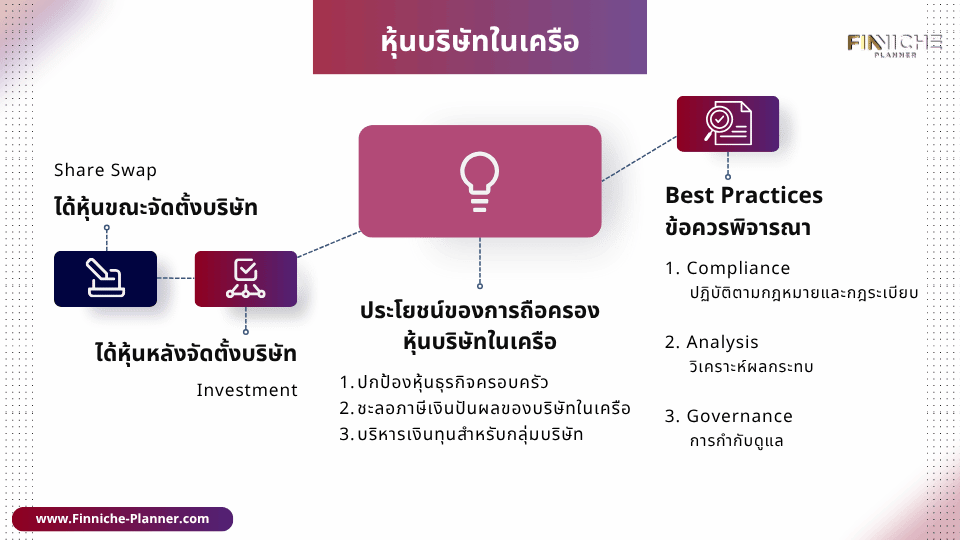
วิธีการได้มาซึ่ง “หุ้นบริษัทในเครือ”
1. ได้มาขณะจัดตั้งบริษัท
ผู้ถือหุ้นบริษัทในเครือ (บริษัทประกอบกิจการ) ใช้ “หุ้นบริษัทในเครือ” ที่ตนถือในการชำระทุนจดทะเบียนของบริษัทโฮลดิ้ง (Share Swap)
ลักษณะหลักของวิธีการนี้คือ ผู้ถือหุ้นไม่ต้องใช้เงินจำนวนมากในการซื้อหุ้นเข้าบริษัทโฮลดิ้ง และผู้ถือหุ้นเดิมจากบริษัทในเครือจะโยกมาเป็นผู้ถือหุ้นในบริษัทโฮลดิ้งตามสัดส่วนการถือหุ้นทันที
2. ได้มาหลังจัดตั้งบริษัท
บริษัทโฮลดิ้งดำเนินการเสนอซื้อหุ้นจากสมาชิกครอบครัวผู้ถือหุ้นเดิมของบริษัทในเครือ (บริษัทประกอบกิจการ)
ลักษณะของวิธีการนี้คือ ใช้เงินในการลงทุนเพื่อการซื้อ “หุ้นบริษัทในเครือ” แต่โครงสร้างการถือหุ้นในบริษัทโฮลดิ้งครอบครัวอาจเป็นสัดส่วนเดิมหรือไม่ก็ได้ขึ้นอยู่กับการจัดโครงสร้างผู้ถือหุ้นตอนจัดตั้งบริษัท
ประโยชน์ของการถือครอง “หุ้นบริษัทในเครือ”
1. ปกป้องหุ้นธุรกิจครอบครัว
เนื่องจาก “หุ้นบริษัทในเครือ” จะถูกรวบรวมมาไว้ในบริษัทโฮลดิ้งครอบครัวที่กำกับด้วยข้อบังคับบริษัท และสัญญาระหว่างผู้ถือหุ้นที่เฉพาะตัว ที่ต้องระบุเกี่ยวกับข้อจำกัดการโอนหุ้น ซึ่งจะทำให้หุ้นธุรกิจครอบครัวไม่ตกไปสู่บุคคลภายนอกโดยไม่ตั้งใจ
2. ชะลอภาษีเงินปันผลของบริษัทในเครือ
ข้อดีนี้เป็นสาเหตุสำคัญที่หลายครอบครัวตัดสินใจจัดตั้งบริษัทโฮลดิ้งครอบครัว ซึ่งการชะลอภาษีนี้ทำให้บริษัทโฮลดิ้งนำมาลงทุนกับบริษัทเดิม หรือเปิดบริษัทใหม่ได้อย่างคล่องตัว
3. บริหารเงินทุนสำหรับกลุ่มบริษัท
- สร้างสมดุลสถานะทางการเงิน: เพราะบริษัทโฮลดิ้งสามารถกระจายเงินทุนไปยังบริษัทในเครือที่มีความต้องการทางการเงินได้ทันที ทำให้มั่นใจได้ว่าไม่มีธุรกิจใดต้องประสบปัญหาการขาดสภาพคล่อง และสามารถรักษาเสถียรภาพการดำเนินงานได้
- เพิ่มการเติบโตทางธุรกิจโดยรวม: บริษัทโฮลดิ้งสามารถส่งเสริมการขยายตัวของธุรกิจเดิม หรือใช้ประโยชน์จากโอกาสใหม่ๆ ได้โดยการลงทุนไปยังที่ๆ มีศักยภาพการเติบโตสูง
- ประโยชน์ทางภาษี: ในบางกรณีการโอนเงินทุนสามารถเป็นประโยชน์ทางภาษีด้วย เช่น บริษัทโฮลดิ้งให้บริษัทในเครือกู้ยืมเงินเพื่อรองรับการขยายกิจการ ทางฝั่งบริษัทโฮลดิ้งจะได้รับยกเว้นภาษีธุรกิจเฉพาะ และฝั่งบริษัทในเครือก็ได้ค่าใช้จ่ายบริษัทเป็นดอกเบี้ยเงินกู้ยืมอีกทางหนึ่ง
- ความยืดหยุ่นด้านการเงิน: ทำให้บริษัทสามารถคว้าโอกาส หรือตอบสนองต่อการเปลี่ยนแปลงของตลาดได้ทันท่วงที ช่วยให้มั่นใจได้ว่าธุรกิจครอบครัวยังคงคล่องตัวและสามารถแข่งขันในตลาดได้
ข้อควรพิจารณาสำหรับ “หุ้นบริษัทในเครือ”
1. การปฏิบัติตามกฎหมายและกฎระเบียบ
- ปฏิบัติตามกฎหมาย: ตรวจสอบให้แน่ใจว่าการโอนหุ้นเป็นไปตามกฎหมาย ทั้งเรื่องการจัดทำตราสารการโอนหุ้น การออกใบหุ้น การบันทึกลงในสมุดทะเบียนผู้ถือหุ้น รวมถึงภาษีที่เกี่ยวข้อง เช่น อากรแสตมป์ในตราสารการโอนหุ้น ภาษีเงินได้บุคคลธรรมดาในส่วนกำไรจากการขายหุ้น เป็นต้น เพื่อหลีกเลี่ยงปัญหาทางกฎหมาย และป้องกันโมฆะกรรมของนิติกรรม
- รายงานการโอนเงินทุน: ควรมีรายงานรายละเอียดของการโอนเงินทุน จำนวน ดอกเบี้ย ระยะเวลาการใช้คืนให้เป็นไปตามมาตรฐานทางกฎหมาย รวมถึงเหตุผลความจำเป็น และผลกระทบทางการเงินต่อบริษัทโฮลดิ้ง และบริษัทในเครือ เพื่อตรวจสอบธุรกรรมระหว่างกันและปฎิบัติตามมาตรการป้องกันการผ่องถ่ายกำไร
2. การวิเคราะห์ผลกระทบ
- คาดการณ์ผลลัพธ์: พิจารณาผลกระทบในระยะยาวต่อสถานะของผู้ถือหุ้นบริษัทโฮลดิ้งครอบครัว ซึ่งรวมถึงสถานะทางการเงินของผู้ถือหุ้น การประชุม สิทธิออกเสียง อำนาจการบริหาร และความเสี่ยงที่อาจเกิดขึ้นเมื่อมีการปรับเปลี่ยนโครงสร้างผู้ถือหุ้น
- ประเมินผลกระทบทางการเงิน: ควรวิเคราะห์ทางการเงินเมื่อมีการโอนเงินทุนอย่างถี่ถ้วน ทั้งฝั่งของบริษัทที่ส่งและบริษัทที่รับเงินทุน เพื่อให้แน่ใจว่าธุรกรรมนี้จะไม่ส่งผลกระทบเชิงลบต่อบริษัทใดบริษัทหนึ่ง และเป็นไปตามเป้าหมายการบริหารและวิสัยทัศน์ระยะยาวของบริษัทโฮลดิ้งครอบครัว
3. การกำกับดูแลและความโปร่งใส
- ผู้มีส่วนได้ส่วนเสีย: ดึงผู้มีส่วนได้ส่วนเสียในสมาชิกครอบครัว เข้าร่วมในกระบวนการตัดสินใจ เพื่อให้แน่ใจว่าการปรับโครงสร้างผู้ถือหุ้นสอดคล้องกับเป้าหมายและค่านิยมของธุรกิจครอบครัว และยังสามารถป้องกันข้อพิพาทที่อาจเกิดขึ้นในอนาคต
- ความโปร่งใส: จัดส่งรายงานทางการเงินของบริษัทโฮลดิ้งและบริษัทในเครือ และสมุดทะเบียนผู้ถือหุ้นให้ผู้ถือหุ้นได้ตรวจสอบเป็นประจำ เพื่อรักษาความไว้วางใจและการจัดการอย่างโปร่งใสภายในบริษัทโฮลดิ้งครอบครัว
Acquiring Shares of Subsidiaries
1. During the establishment of the Family Holding Company
In this method, shareholders of operating companies (subsidiaries) use their existing shares to register the capital of the Family Holding Company through a share swap.
The key advantage is that shareholders do not need to invest a large amount of money to transfer their shares. As a result, they instantly become shareholders of the Family Holding Company in the same proportion as their original shareholding in the subsidiaries. This approach streamlines the process while maintaining equity balance among family members.
2. After the establishment of the Family Holding Company
Another approach is for the Family Holding Company to buy shares from existing shareholders of the subsidiaries.
This method involves using investment capital to acquire shares, which may or may not maintain the same shareholding structure within the Family Holding Company. The final structure depends on the specific needs and agreements within the family. This approach provides flexibility in restructuring ownership while consolidating control under the Family Holding Company.
Benefits of Holding Shares in Subsidiaries Through a Family Holding Company
1. Safeguarding Family Business Ownership
By consolidating the shares of subsidiaries into a Family Holding Company, you protect family business shares from being transferred to outsiders. This is achieved through clear articles of association and shareholder agreements that restrict the transfer of shares, ensuring the business remains within the family.
2. Delay Dividend Tax of Subsidiaries
One of the most significant advantages is the ability to delay dividend taxes from subsidiaries. This tax deferral gives the Family Holding Company the financial flexibility to reinvest in existing businesses or launch new ventures, driving long-term growth.
3. Capital Management
- Balancing Financial Needs: The Family Holding Company can allocate funds to subsidiaries that require immediate financial support, maintaining liquidity and operational stability across the business.
- Seizing Opportunities: By redirecting funds to high-potential subsidiaries, the Holding Company can fuel expansion and capitalize on emerging opportunities.
- Tax Optimization: In some cases, capital transfers can be structured to take advantage of tax benefits, such as the Family Holding Company can lend funds to subsidiaries for business expansion, benefiting from exemptions on specific business taxes. At the same time, subsidiaries can treat loan interest as a deductible expense.
- Financial flexibility: Capital transfers provide the Holding Company with the flexibility to quickly invest in new opportunities or respond to market changes, ensuring that the family business remains agile and competitive.
Key Considerations for Acquiring Shares of Subsidiaries
1. Legal and Regulatory Compliance
- Adhering to Laws: Ensure that all shares transfers comply with laws, such as preparing a proper share purchase agreement, issuing share certificates, updating the shareholders registry book, and addressing related taxes like stamp duty and personal income tax on share sale profits. Proper compliance prevents legal issues and ensures transactions are valid and enforceable.
- Documenting Transfers: Keep detailed records of all capital transfers, including the amounts, interest rates, redemption periods , and justifications for each transaction. And it should include the necessity and financial impact on the Holding Company and its subsidiaries. Clear documentation ensures compliance with intercompany transaction regulations and prevents disputes or accusations of profit transfer.
2. Impact Analysis
- Forecasting Outcomes: Consider the long-term impact to shareholders in Family Holding Company including their financial position, meeting right, voting right, management authority and any risks associated with changes to the shareholder structure.
- Assessing Financial Health: Before transferring capital, conduct a thorough financial analysis of both the sending and receiving subsidiaries to ensure that the transfer will not negatively impact any company and align with goals and long-term vision of the Family Holding Company.
3. Governance and Transparency
- Involving Stakeholders: Engage key stakeholders among family members in the decision-making process to ensure that shareholder restructure aligns with the family’s visions and values. This collaborative approach reduces the risk of future disputes.
- Maintaining Transparency: Regularly update financial reports of the Family Holding Company and its subsidiaries and the shareholders registry book keep all shareholders informed. Transparent communication builds trust and reinforces confidence in the Family Holding Company’s operations.
🔖อ่านบทความของเราในหัวข้ออื่นๆได้ที่นี่
สนใจสอบถามข้อมูลเพิ่มเติมเกี่ยวกับการจัดตั้งบริษัทโฮลดิ้ง Holding Company
หรืออยากนัดปรึกษากับเรา 📌 [ฟรี] 1 ชั่วโมงได้ที่ Google Calendar
อีเมล : Finniche.Planner@gmail.com
หรือกรอกแบบฟอร์มที่ Contact Us
ฟินนิช แพลนเนอร์ ที่ปรึกษาธุรกิจครอบครัว
#ที่ปรึกษาธุรกิจครอบครัว #ธุรกิจครอบครัว #FamilyHoldingCompany #โครงสร้างบริษัท #โครงสร้างผู้ถือหุ้น








